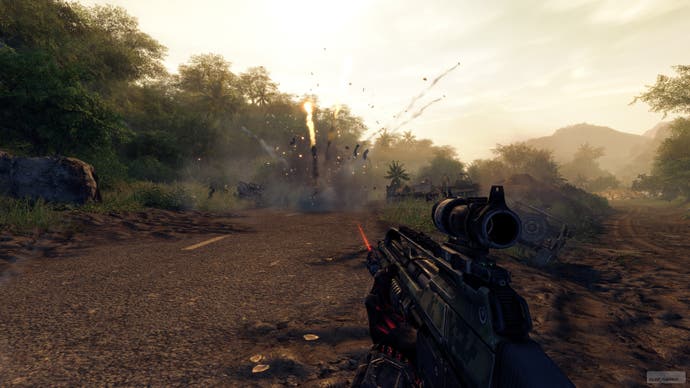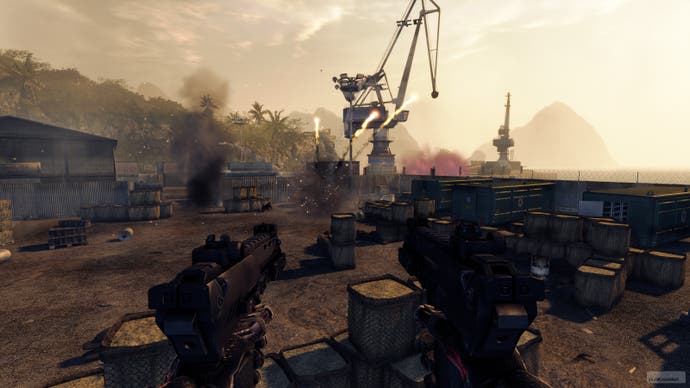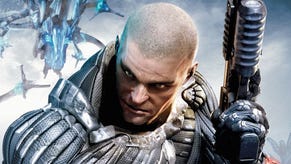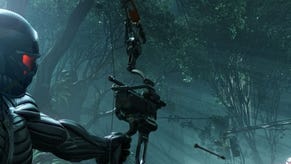Crysis Warhead
Isle be back.
With our ally safely at the extraction point, we head for a nearby harbour. The objective here is to download something or other (probably two-for-one Wagamama vouchers) from an enemy terminal, but for us it's a chance to see a few more of Warhead's new tricks up close, as we fight our way from one building to the next. There are subtle changes, such as the ability to automatically pick up ammo as you move over it, and more noticeable ones, with entirely new weapons like the grenade launcher and twin-wielded SMGs. Large or small, every new idea seems carefully calibrated to speed up the pace of the game, and make the encounters more explosive.
The original nanosuit powers remain unchanged, however, and success in the heat of battle still turns on the speed and imagination with which you can chain your skills together - getting close with stealth and switching to strength to dish out some quick violence before dashing off to safety again at double speed, for instance.
Equally, the game's environment remains as destructible as it is beautiful, and in the middle of a more intense skirmish, with barrels exploding, trees flying through the air and the physics engine getting a real workout, it seems like business as usual. Like Valve, Crytek know how to turn a single object into a set-piece, and there are opportunities for improvisation everywhere: a huge wooden spool of wire from a container ship provides a useful refuge, then switches to moving cover once you realise you can set it in motion, and finally becomes a weapon, as it picks up speed rolling downhill.

The North Koreans we fought seemed slightly smarter this time around, more eager to flank, and happy to fall back and regroup, but a big question still remains over whether this Crysis will suffer like the original when the aliens eventually enter the mix. "We've definitely spent a lot of time and effort working on the alien AI," says O'Donnell, who admits it was one of the main problems with the first game. "What we've tried to do is make them feel more human this time. We've incorporated some of the human AI values in there. They're reacting to your actions: if you throw a grenade, they'll evade it, they'll try and flank you, and it makes the experience more intelligent than just firing at these guys who run across the screen."
With multiplayer slotting in alongside the main campaign, Crytek is clearly hoping that Warhead's generous content, along with a budget price point, will lure in those who stayed away the first time, scared off by the minimum specs. "We got a bad rap in the community because of that. But actually it wasn't nearly as bad as anybody thought, which is what we're trying to make clear now," says O'Donnell.

"The technology's caught up, and it's cheaper to get a decent system." EA is currently unwilling to divulge how much the specs have changed since the original game, however, and the publisher is equally tight-lipped on what kind of copy protection will be in place. Given the effect illegal downloads had on the first game's sales, you can probably expect something involving retinal scans and blood samples.
There are many who argue that there's something perilously old-fashioned about Crytek's fixation with brand new technology. While it's never likely to turn off DirectX 10 and start churning out puzzle games, it remains a brave move to go ahead with another PC exclusive when most other companies are going multi-platform. A console Crysis is inevitable - and there are still genuine sequels planned - but for the time being, whether you view Warhead as a shallow cash-in or pure fan service, what we've seen so far suggests it's still more than enough to make many console gamers slightly jealous.
Crysis Warhead is due out on PC this autumn.




